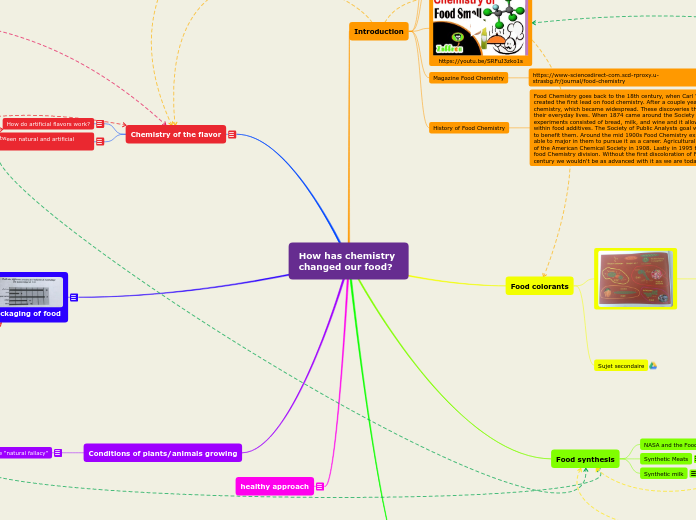How has chemistry changed our food?
Introduction
Sujet secondaire
french research
Magazine Food Chemistry
History of Food Chemistry
Food Chemistry goes back to the 18th century, when Carl Whilhelm Scheele isolated malice acid from apples. This created the first lead on food chemistry. After a couple years he published his first book on agricultural and food chemistry, which became widespread. These discoveries they were making were with food they interacted with in their everyday lives. When 1874 came around the Society of Public Analysts was created. Their earlier experiments consisted of bread, milk, and wine and it allowed them ti discover food quality, and combinations within food additives. The Society of Public Analysts goal was to apply analytical methods to share with the public to benefit them. Around the mid 1900s Food Chemistry expanded and spread to colleges and universities to be able to major in them to pursue it as a career. Agricultural and Food Chemistry division was developed as a result of the American Chemical Society in 1908. Lastly in 1995 the Institute of Food Technologist established the final food Chemistry division. Without the first discoloration of Food Chemistry by Carl Whilhelm Scheele in the 18th century we wouldn't be as advanced with it as we are today.
Food colorants

natural colorants
ß-carotene (E160)- can be extracted from plants such as carrots, or algae, sometimes obtained by fermentation of bacteria or chemically synthesized - can be used as an additive in various foods, in some Orange juice.
The beetroot red pigment (betalain and not, as often thought, anthocyanins), which naturally gives the red color to this vegetable, and which is coded E162 when it is used as an additive.
The molecules of the family of anthocyanins, which we know inevitably we drink from red wine. These natural pigments give color to the grape, blueberry, strawberry and cherry ... They are also prized by manufacturers that use under the name E163 in various finished products (yogurt, juice, etc).
Some alimentary dyes are exclusively synthetic origin. For example tartrazine E102 is interesting to consider. it comprises the famous groupement "azo" whose chemical structure combines with aromatic rings and gives the origin of its free yellow beautiful colour. It is then used to color sodas, pastries or rice (in the paella for example)
Sujet secondaire
Food synthesis
NASA and the Food Synthesis Project
Synthetic Meats
Synthetic milk
Smell
artificial flavors
Chemistry of the flavor
How do artificial flavors work?
The fundamental difference between natural and artificial flavors

Packaging of food
Plastic
Plastic bags and films
Plastic bottles
Glass
Paper
Carton Bricks
Metal
Steel beverage cans
Aluminum beverage cans
Tin cans
Beverage cans of future
Evolution for packaging
Conditions of plants/animals growing
Exploitation of consumers by the “natural fallacy”
example
